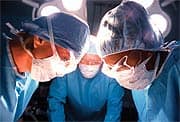Life Extension Magazine®
Let me let you in on a little secret: When the heart stops beating, it’s not the end. As it turns out, “life and death” is not a black and white issue. There is a gray zone—a faint no man’s land where you are neither truly dead nor actually alive. In order to control it, in order to cheat death, we have to first, better understand it. We’re used to thinking about dying in stark terms. Dead or alive. You’re here and then you’re gone. In our imagination, this is how the moment of death plays out: the villain, or hero, or soldier, gasping last words, stretching out a hand... until his eyes roll back in his head and we know it’s all over. Or the cancer patient, surrounded by family. A light flickers behind her eyes, then goes out. You’ve read it in a thousand stories, seen it in a thousand movies, a hundred episodes of “ER.” The alarm sounds. The monitor flatlines. Time of death, 2:15. It only takes a few minutes for life to slip away. Without a heartbeat, circulation slows to a halt. Blood is no longer flowing in your brain, or any other organ. It takes just a couple minutes before everything goes dim, and now you’re blissfully unaware of the catastrophe unfolding inside your body. Starved of blood, the first organ to suffer is the brain, which in happier times consumes about 20 percent of all the oxygen the body takes in, even though it constitutes just two percent of our body mass. After just ten seconds without oxygen, the brain’s function slows. Without oxygen or signals from the brain, other organs soon break down as well. Our diaphragm muscles no longer contract and release, to bring in air. The kidneys stop filtering blood. At the same time, an elaborate chain of chemical reactions triggers a breakdown in cells throughout the body.
This is the process of dying. Whether because of a car accident, a blockage in an artery or a tumor somewhere in your body, it is generally understood that when the heart stops beating, life has ended. I have seen this play out more times than I care to remember. As a doctor, I can assure you that when the heart stops beating, it’s not the end. Death is not a single event but a process that may be interrupted, even reversed. And here’s the exciting part: at any point during this process, the course of what seems inevitable can be changed. It’s been said that life is a terminal condition, that nothing lasts forever, and the minute we’re born we start the long process of our end. I think everyone, at one point or another, has probably wondered: does it really have to be that way? Therapeutic hypothermia was first used in the 1940s and 50s, when pioneering heart surgeons like Walt Lillehei started using hypothermia to extend their time in the operating room. Prior to the 1940s, most open heart surgeries were thought to be impossible, because anything more than a very simple repair could not be completed in the few minutes that the heart might survive without oxygen. By chilling a patient’s blood, Lillehei found that he could buy precious minutes. A heart that only lasted 10 minutes at room temperature, could survive an hour when it was cooled to 20 degrees. There’s no easy answer as to how or why hypothermia really works. The first person I thought to ask was Dr. Lance Becker, an emergency physician and researcher who runs the Center for Resuscitation Science at the University of Pennsylvania Hospital. Becker says the hypothermia procedure is still mysterious. “We’re pretty sure it doesn’t work on just one mechanism. I’ve looked at 20 or 30 ideas [in the lab] that have been postulated, but the truth is, nobody knows,” just why or how it helps. What does seem clear is that as a medical therapy, hypothermia is a way to buy time. I explain it this way: chest compressions and artificial respiration provide oxygen that the body needs, but hypothermia sort of slows the body down. That in turn reduces the need for oxygen, so the body can last longer on what’s already there. Studies show that every one-degree (Celsius) drop in body temperature will lower cellular metabolism by roughly five to seven percent. Becker’s best guess is that this reduced metabolism also slows the chemical reactions that are triggered by oxygen deprivation and which prove so damaging to cells. There’s no doubt this is complicated. Hibernation is a good example of cold going hand in hand with lower metabolism; mammals who hibernate can survive, even thrive, for long periods at far below their usual body temperature. In these animals, cold doesn’t just slow metabolism the way it thickens a jar of molasses. Rather, it triggers a whole set of biochemical changes. Hibernation seems to be caused by different factors, depending on the animal, but cold weather is a common trigger. Take ground squirrels. For ground squirrels, as soon as temperatures dip below freezing on a regular basis, the animals go into a near-complete torpor. Their heart rate, usually around 200 beats per minute, slows to less than 10. The squirrel’s body temperature will drop from a warm-blooded 37 degrees to just one or two degrees above the outside temperature. They stay in that state, using just a bare minimum of energy, for at least six months.
True, humans aren’t squirrels, but believe it or not, we have some of the same adaptive ability. For example, immersion in cold water triggers something called the diving reflex, or Vagal reflex. You could think of it as throwing the body into a state of semi-hibernation. Blood flow to the extremities nearly shuts off completely. The heart and brain use as little as a tenth of the oxygen they normally require. Survival time is stretched out. Dr. Stephan Mayer, too, knew those statistics well. Mayer is a crusader for therapeutic hypothermia, fretting over the doctors who are reluctant to use it as a treatment, and the medical organizations, who in his view, don’t do enough to promote it. Mayer first encountered hypothermia in a very different context, on the grounds of an ancient mental hospital in Westchester County, New York. In October of 1986, Mayer was a third-year medical student, and he spent most of that month looking after young men who had basically fallen apart under the strain of their freshman year in college. “Depression, bipolar disorder, borderline personality disorder—they were all these young guys who had gone off from home for the first time, and just decompensated under the pressure.” One night, a young man came into the unit in a straitjacket, clearly in the midst of a complete breakdown. “He was in this psychotic rage,” says Mayer. “We were giving him doses, mega doses, of thorazine, haldol, you name it, and it wasn’t touching him at all. He just kept going. And then someone said, ‘Get the cold sheets!’ And I’m like, ‘what’s that?’” Next thing he knew, says Mayer, he was helping more than a dozen doctors and orderlies to hold down the unruly patient, while someone else soaked the sheets in ice water and rolled up the patient like a caterpillar in his cocoon. “It was amazing. He immediately calmed down. It worked like nothing else. It was right away. [The young man] said something like, ‘oh, I think I feel okay now.’” Curious, Mayer asked around and learned that cold sheets had been widely used in psychiatric hospitals in the early 20th century. The practice had widely been abandoned, but not by the elderly psychiatrist who ran the institution where Mayer spent that eventful fall. Mayer knew he didn’t really understand what he had witnessed, but something about it left a deep imprint. “I never saw it again, but I was very impressed that something natural, and so simple, could have such an impact. It was like his brain was boiling with rage, and they just cooled it down. I thought that for such a natural intervention, it was very powerful.” That little lesson would one day set the template for his life’s crusade.
As Mayer embarked on his very first hypothermia study, he wanted to see if therapeutic cooling might reduce the swelling from brain injury, reduce the damage, or both. “Decades ago, the only use of hypothermia was in selected, super-high-risk neurology and cardiology surgeries, where they needed to completely stop circulation for an extended period of time,” says Mayer. This was the legacy of the pioneering heart surgeons. In those early years, hypothermia developed an ominous reputation. While it made daring surgeries possible, patients suffered enough side effects to give doctors serious pause. Patients who were cooled below 80 degrees were prone to developing heart arrhythmias. They were also prone to strokes and other types of internal bleeding, since blood that’s chilled doesn’t clot as well. Most of those early cardiac patients would get better in the short term, but then eventually died of pneumonia. The problem was in the 1940s, there were no artificial ventilators, so comatose patients had to breathe on their own and their lungs often filled with various secretions. On top of that, hypothermia tends to suppress the immune system, so these patients would develop fatal infections. But even then, there were hints and clues that it might be done safely. For example, a few years later surgeons at the University of Minnesota reported cooling a 51-year-old female cancer patient to just 48 degrees for her surgery, and re-warming her with no apparent problems. Other experimenters, working with monkeys, also reported good results using extreme low temperatures, and there were even reports of physicians using hypothermia, successfully, in the treatment of cardiac arrest patients. But by the 1990s, hypothermia was still out of favor due to safety concerns. Mayer and a few other doctors decided it was time for a fresh look. Mayer suspected that the real problem in the 1950s lay not with the cooling itself, but with the follow up care and nascent level of life support equipment. He and other doctors felt that some of the pitfalls could be avoided. For one thing, they wouldn’t be cooling people to such an extreme degree—they hoped to get results by cooling to around 90 degrees, not 60 or 70. Just as important, in the modern critical care setting they could do much better preventing and treating complications like pneumonia. When the results came back for the pilot study, they were solid—the patients did no worse—and he published them in tandem with a group of German researchers who had done a similar experiment with another 42 patients. The field of neuroscience, long seen as one where doctors could do little for their patients, was finally shifting, and so was that line between life and death. As is usually the case in medical discovery, our best new research is built on existing research. For example, one of the early articles in Mayer’s journal was about a discovery that took place when I was still a resident. The FDA approved the use of a drug called Tissue Plasminogen Activator, or tPA, to treat patients with strokes. In one type of stroke, blood flow to part or all of the brain is cut off by a clot. Without blood flow, that portion of the brain dies. tPA is a great tool, because it can almost immediately break open the clot and restore blood flow to the brain. The problem is, it needs to be given very quickly—within three hours of the start of symptoms—for it to help. For this reason, it’s estimated that fewer than five percent of stroke patients actually receive this vitally important drug. Enter the Ice Doctor. Hibernation is a good example of cold going hand in hand with lower metabolism; mammals who hibernate can survive, even thrive, for long periods at far below their usual body temperature... it triggers a whole set of biochemical changes. A handful of neurologists—Mayer included—thought that hypothermia could be a vital addition to the arsenal. They started experimenting—on the theory that hypothermia would reduce the brain’s need for oxygen during the crucial first days of recovery, and so reduce the permanent damage. This would reduce the damage caused by lack of oxygen and perhaps extend the window of effectiveness for other therapies, like tPA. Unlike the early cardiac surgeons, Mayer and these other Ice Doctors used a mild form of hypothermia, generally cooling the body by five to ten degrees. No doubt, Mayer had cold on the brain, and in 2000 he got more encouragement. A European research team, led by the Austrian cardiologist Fritz Sterz, reported that chilling patients by about seven degrees Fahrenheit was enough to sharply improve the outcome in patients who suffered a life threatening cardiac arrest. Think about that. Think about the number of times we hear, “He or she died of a heart attack.” All the technology, in the world’s best hospitals, could only do so much. But take away seven degrees Fahrenheit... When he was describing all this to me, it seemed counterintuitive that a neurologist would dedicate himself to changing cardiac care around the country. But, the Ice Doctor was hooked. The thing was, Mayer couldn’t start cooling cardiac patients on his own, simply because he thought it was a good idea. Just because an article gets published, doesn’t mean it will become accepted practice. That’s doubly true if the work is published overseas and even truer in a field like cardiac care, which is so strictly bound by rules and guidelines. In the U.S., no one was doing it. But in Europe, its use continued to grow, and a decade later—medicine moves slowly—there was more ammunition for people like Mayer, and for other devotees like the UPenn team led by Lance Becker. Once again, it came from Fritz Sterz’ group in Austria, this time under the heading of the Hypothermia After Cardiac Arrest Study Group. The Austrians, led by Dr. Michael Holzer and Sterz, reported in the New England Journal of Medicine that they had cooled 136 cardiac arrest patients; 55 percent emerged from the hospital with healthy brain function. In a control group of 137 patients—cardiac arrest victims who were not cooled—just 39 percent got better. It wasn’t a large study, but it was a strong result published in a major U.S. medical journal. Mayer thought it would be decisive, a triumphant breakthrough, for doctors like him who thought that hypothermia should be the standard treatment. | ||||
| But that’s not how it worked out. With such common and deadly illnesses as heart attacks and stroke, physicians are loathe to experiment—they stick closely to protocol. This is especially true in the United States, where the fear of lawsuits makes doctors especially unwilling to deviate from what might be called the accepted standard of care. For three years after the publication of Fritz Sterz’ groundbreaking European study, a handful of American doctors fumed as the AHA refused to update its guidelines to require cooling as a treatment for cardiac arrest. Stephan Mayer was especially steamed. In his view, as long as hypothermia was not considered “standard of care,” hospitals could rationalize not doing it. After all, if the AHA didn’t think it was absolutely necessary, many would ignore it. In 2005, its guidelines for treating cardiac arrest were re-written, as they are every five years, and they did list therapeutic hypothermia as a recommended treatment—but still not that elusive standard of care. To shift that line, once and for all, would take a decision from the Food and Drug Administration. In 2004, an FDA panel that makes recommendations on medical devices gathered to discuss the evidence for hypothermia, and whether companies could specifically market cooling systems for the treatment of cardiac arrest patients. The European study was touted, along with a second study from Australia, which also showed that cooling helped survival. On the other side of the world, Mads Gilbert was certainly smiling as he followed the developments. But things didn’t go as Gilbert and Mayer, among many expected. An influential FDA representative was not swayed by the evidence of a benefit from hypothermia. Dr. Julie Swain, a prominent cardiologist, laid into the two studies. She argued that they were too small to suggest a real benefit, and pointed to studies of hypothermia in other groups of patient—heart attack victims, and people who suffered head injuries —as showing no benefit at all. What’s more, she said, patients in those other studies suffered higher rates of side effects like shock and bleeding. According to Lance Becker, who was at the meeting as an expert consultant, the mood in the room was tense. Becker tried to persuade the panel that hypothermia was worth the risk. Of course the studies were relatively small, he argued, since most cardiac arrest patients die before they even reach the hospital. He pushed on, saying that the two studies, together, provided more evidence of benefit than existed for many other, more accepted therapies. Another consultant, Dr. Joseph Ornato from Virginia Commonwealth University, backed Becker, saying the European and Australian studies were well-designed, and that it would be wrong—and extremely difficult—to wait for larger studies.
But the enthusiasm had gone out of the room. A third consultant, Dr. John Somberg from Cornell, was blunt. “Forget about their being in the New England Journal. I just do not believe these two studies meet any FDA advisory standard of approval.” Somberg, who was a former member of the FDA committee making the decision, went on to compare the two studies to a poorly balanced stack of cards. In the end, his opinion carried the day. Despite the efforts of doctors like Stephan Mayer, hypothermia would not become standard of care. The Ice Doctors had lost this battle. Reached by phone four years later, Swain still hadn’t changed her mind. She told us that even at modest temperature levels the benefits of hypothermia do not outweigh the risks. You may be wondering why I included this losing battle by the Ice Doctors. Well, herein lays one of the great challenges of medicine. When does an experimental treatment become a standard tool in the doctor’s bag? Move too slowly, and you’re holding back a treatment that could save thousands of lives. Move too quickly, and you might miss side effects. Look what happened in the case of Vioxx. The FDA approved Vioxx as an anti-arthritis medication, only to take it off the market five years later, when it became apparent that the drug was linked to heart problems. The FDA says Vioxx probably caused more than 88,000 heart attacks, in all. Maybe they all could have been avoided if the FDA had waited for more evidence before agreeing that the drug was safe. Of course, critics like Swain and Somberg say the research on hypothermia is thin, and considering the potential risks, not enough to justify its widespread use. But there are major hurdles to actually doing more studies. In a true Catch-22, in 2008 the National Institutes of Health rejected a proposed study at Duke that would have tested therapeutic cooling against a non-cooling regimen, on the grounds that it wouldn’t be ethical to withhold cooling. If you think it’s confusing—you’re right. You’ve got the FDA saying it’s wrong to cool cardiac arrest patients because we don’t know if it works, the AHA saying it’s probably a good idea to use the treatment and the NIH saying the evidence is so strong, it’s unethical NOT to cool them.
Whatever the reason, hospitals and doctors in the United States have been slow to adopt the treatment. Medivance, which makes the most widely used therapeutic cooling pads, says that just a few hundred U.S. hospitals—of nearly 6,000 total—have even installed the necessary equipment. This sluggish response is especially bewildering, considering the lifesaving success that’s taken place in institutions that do adapt the use of cooling. Just one example: after making hypothermia a standard protocol, in 2005, the University of Richmond Hospital reported that the death rate for cardiac arrest patients was cut in half. I was incredulous that this lifesaving treatment could be ignored by so many. As I described it to my friends and colleagues, they thought it was outrageous. What was the reason? Raina Merchant, a physician and researcher at the Center for Resuscitation Science, tried to explain. Merchant has conducted a number of studies and surveys, talking to hospitals and doctors about their use of hypothermia and other therapies. She is 31 years old, an accomplished physician, but she looks almost like an undergraduate—petite, with studious glasses. She was dressed in a neat black dress. She is African-American, which stands out in the world of leading emergency physicians and cardiologists. I started right into it: why don’t more doctors use hypothermia, when the evidence seems to show it’s a lifesaver? “At first, we used to think it was because it wasn’t in the guidelines. But now, since 2005, we have that.” By this Merchant was talking about the modest recommendation from the American Heart Association. You might think it costs too much, but according to Merchant, that’s not the problem either. When I take non-physicians to an ICU and show them the hypothermia equipment, they are always a bit surprised. I think they imagine futuristic ice tubs with bluish solutions coursing through the patient’s blood stream. The truth is, hypothermia is not especially high-tech. Doctors either pump cool saline or fresh water through a patient’s veins, or wrap cold solution-filled pads around the torso and extremities. Picture the opposite of a hot water bottle. To be fair, the box used to cool and pump the iced slurry solution costs about $25,000. But even if $25,000 sounds like a lot of money, compared to therapies like dialysis, it’s cheap. Cost-benefit studies showed it would actually save money. Merchant told me, “If you cool even one patient and avoid complications, you save more than the cost of dozens of boxes. It’s cheaper to cool, than not to cool.” And even the box isn’t absolutely necessary. Ice bags will do the trick, although it’s harder to control the temperature. According to Lance Becker, for years heart surgeons in Russia would pack a patient’s chest cavity with ice until it was cold enough to stop the heart. Fritz Sterz, the Austrian anesthesiologist who pioneered the use of hypothermia in Europe, tells of a case where he used bags of frozen vegetables from a grocery freezer to cool a patient who had collapsed in a grocery aisle. In other words, it is a recommended, rather cost-effective therapy. I had to ask: “What am I missing here?” In Merchant’s view, the biggest hurdle to widespread use of hypothermia is a psychological one. Her colleague in the Upenn emergency department, Dr. Ben Abella, explained. “It’s a paradigm shift,” he told me. “We’re using this for people whose eyes are yellow, they’re not moving, and you’re telling doctors to cool these people for 24 hours—then warm them up for a day, then take them to the cath lab. You’re doing all these things for people who look dead, sound dead and act dead. It’s asking a lot.” It may be that lack of hope leads to inertia and apathy, but as I dug deeper, I found even more reasons therapeutic hypothermia has been slow to catch on. Here’s one that will probably make you angry: using hypothermia might be inexpensive and effective, but it isn’t nearly as simple as rolling out a new miracle drug. In this case, being inexpensive is not necessarily an asset, but a potential liability. For example, let’s say you’ve invented this new medication. You run studies comparing the new pill to a placebo, publish the results, and then—assuming it works—you send the sales team to tell physicians about it. If they’re convinced, they start writing prescriptions. There is no doubt money to be made. By contrast, a single doctor, as compared to a big company, no matter how motivated, can’t just start writing prescriptions for hypothermia. He or she has to convince a hospital to buy the equipment; it might not be terribly expensive as medical equipment goes, but it’s enough that a purchasing committee needs to get involved. And it gets even more complicated. A cardiac arrest patient is as likely to be treated as a neurology patient as a cardiology patient, and in either case he or she almost certainly starts in the emergency department. All three of those departments have to not only agree that hypothermia is useful; they have to agree on where to get the money to buy the gear. Then they have to figure out a protocol for identifying patients who would be helped by the treatment—and train people to do it properly. This would be hard enough in a single hospital department; with two or three departments involved it can be a bit like herding cats. Even a good idea, without the millions of dollars that are often backing a new drug, have a hard time getting off the ground. There is a sometimes ugly underbelly of medical progress, and this is just one example of it. On the UPenn website, Becker and his colleagues have posted the hypothermia protocols from more than two dozen medical centers. There’s no special qualification; someone just has to be willing to email the institution’s guidelines. Since setting up the website, the Center for Resuscitation Science has received thousands of emails from hospitals who want to set up their own hypothermia programs. The hope is that by making the details easily and publically available, they’ll inspire others to start—and take away the excuse that it’s all too complicated. You see, what Raina Merchant found is that the most common reason that hospitals start using hypothermia is when there’s a doctor, or even a nurse, who knows about hypothermia and talks it up among their colleagues. If there’s no local champion, no one gets cooled. Like a lot of things in medicine, it boils down to word of mouth. The squeaky wheel. Simply put, despite all the technology and years of studies, hypothermia still needs champions like Stephen Mayer. In early 2009, the New York Fire Department started a bold new experiment, cooling cardiac arrest patients in the field. “The plan is to make therapeutic hypothermia the first thing out of the bag, right after defibrillation,” says FDNY Medical Director John Freese. “Once we get the breathing tube and an IV placed, we’ll just give everyone two liters of cooled saline.”27 In preparation, Freese has had to identify which hospitals are able to efficiently cool patients coming in from the field. After all, it would make no sense to cool a cardiac arrest victim in their home, only to let them warm up 30 minutes later when they reach the hospital. The process has not been tension-free. There was shouting at one meeting, when the head of a major hospital group said he didn’t want to publically compare survival rates at different hospitals—it might embarrass someone. Still, similar efforts are underway in Arizona, Wisconsin and Seattle. Lance Becker insists that doubters are missing the forest for the trees, that whatever side effects exist are minimal in contrast to the life preserving power of cold. “No matter which direction you go, whether you’re conservative or aggressive, we know it will save people’s lives. How many lives have lost, because we delayed implementing this for a year or two? I have to think that we’ve lost lives, because we’ve failed to move aggressively.” The practice of medicine is changing constantly. The innovation isn’t always for the better—ask one of the women who took thalidomide in the 1960s, to ward off morning sickness. And innovation is never easy—most of the first heart transplant patients died within hours or days. But the next round of transplants went better, and then better, and today thousands of heart transplant patients live rich lives because of the bold pioneers of the 50s and 60s, and their brave subjects. What I have learned is that this cycle: desperation, desperate measure, apparent miracle, insight, common practice—shifts the line in the sand. That’s how medicine moves forward. From the book, Cheating Death: The Doctors and Medical Miracles that Are Saving Lives Against All Odds by Sanjay Gupta, MD. Copyright © 2008 by Sanjay Gupta, MD. Reprinted by permission of Grand Central Publishing, New York, NY. All rights reserved. Sanjay Gupta, MD, is a practicing neurosurgeon and associate chief of neurosurgery at Grady Memorial Hospital and assistant professor at Emory University Hospital in Atlanta. He is Chief Medical Correspondent at CNN, a columnist for Time Magazine, and a contributor to 60 Minutes and The CBS Evening News with Katie Couric. For more information, you can visit: http://drgupta.cnn.com/h35
|






